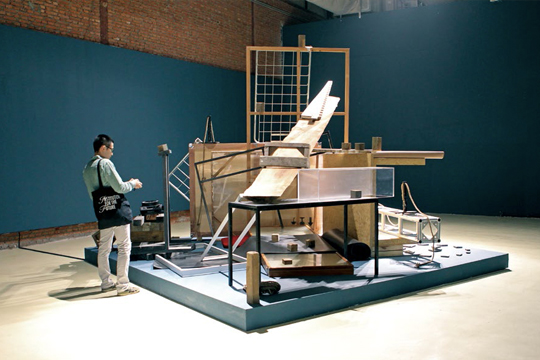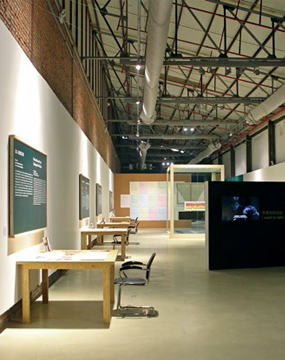SHENZHEN OCT CONTEMPORARY ART TERMINAL
| May 17, 2013 | Post In LEAP 20

HISTORY LESSONS: REFLECTIONS ON OCAT PUBLISHING
ALTERNATIVES TO RITUAL: A CASE STUDY OF SHENZHEN OCT CONTEMPORARY ART TERMINAL
On January 26, two exhibitions opened to mark OCAT’s eighth anniversary: “History Lessons: Reflections on OCAT Publishing,” curated by Fang Lihua and Li Rongwei, and “Alternatives to Ritual: A Case Study of Shenzhen OCT Contemporary Art Terminal,” curated by Biljana Ciric.
“History Lessons: Reflections on OCAT Publishing” attempts to collate eight years’ worth of practice and exploration at OCAT from the perspective of its publications. Departing from the established modes of display for exhibitions of this kind— documents laid out for public viewing, arranged comprehensively and chronologically. Instead, using the bare form as a point of departure, it attempts to pose new questions. In the words of Fang Lihua, “this project is a process of constant self-interrogation, and of the attempt to, to our fullest capacity, respond to the questions posed.” Such an ambitious and inquisitive approach is in itself undoubtedly worthy of investigation.
Irrespective of the actual significance of publishing to the history of OCAT, the approach the exhibition takes is particularly relevant within the context of contemporary China: What role does publishing play within systems of art production? What are the shifts and plights of contemporary art publishing? Can publishing itself be a practice central to contemporary art? This exhibition offers no plain answers to any of these questions, but instead, through a review of past art practices, curation, criticism, art-historical narratives, and intellectual history, formulates a set of new questions: What is the relationship between image and text? What is the relationship between publishing and exhibition? What is the relationship between publications and discussion forums? How do we acquire knowledge? What is the relationship between artworks and project research? What is history? What is research? What is the role of translation? What role does “dialogue” play within research? What is the fundamental approach of the study of art history? Can “visual speech” become a mode of writing? How can publications present images? What is interesting is that in deploying the exhibition, the curators did not consciously construct a thread or framework; instead, all the questions emerge and disperse together on a synthetic and homogeneous plain. The exhibition bears no organic visual structure or lexical system, making it difficult to find strict logical connections between the different questions. In appearance, it is more akin to one of Boris Groys’s knowledge installations, which the viewer can freely enter and explore.

If these publications can be considered as captured moments of Chinese contemporary art history, this exhibition is a recapturing of the history of OCAT from the perspective of publishing. Though, in this case, the history captured possesses no logic or objective, and provides no answers. That which is accumulated here is merely fragments of thoughts and questions. In the words of Foucault, to “capture” is to consciously search for a new kind syntactical system of knowledge production. On the one hand, this history is built on the exhibitions and publications curated by OCAT director Huang Zhuan; on the other hand, it differs from his own thinking and mode of practice. Although Huang himself has spoken much about “capturing,” this kind of syntactic system is clearly different from his (former) historical and intellectual perspective. Or rather, at OCAT, a possible diachronic narrative history has been compressed into an incessantly questioning synchronic domain.
Seven artists were invited to participate in the exhibition: Liu Ding, Qin Jin, Qiu Anxiong, Shu Qun, Wang Junyi, Xu Tan, and Zhou Li; from their contributions, certain issues and their historical relevance emerged. Needless to say, their inclusion itself engendered a certain productivity, though in actuality, it was more a re-productivity, the contradiction being that while the logic and structure of the exhibition remain open, the excessive use of text and image, as well as the exhibition’s integrated layout, appear a bit too rigid and mechanical. Apart from Zhou Li’s “fragments of memory,” the rest of the artists’ practices are in a sense engulfed by the visual narrative of the exhibition, unable to shake off its overarching narrative.
All (good) things come in pairs: “Alternatives to Ritual,” curated by Biljana Ciric, also takes OCAT as its focus. Six artists and curators were invited to participate: Nikita Yingqian Cai, Guo Ying, Hu Yun, Li Ran, Liu Shiyuan, and Ciric herself, each exploring different topics: case studies of OCAT artists, OCAT Library projects, institutions and the audience, individual practice and exhibition, the institution and collection, established conventions and production, each respectively examining possible issues common to institutions, artists, and curators. The freedom of identity transformation on display— Ciric’s invitation of two curators, Nikita Yingqian Cai and Guo Ying, as well as her participation as both curator and artist—does not only accommodate the need for dialogue and exchange. More importantly, it signals a break from the “traditional, rigid subject-object relationship of curator-artist,” “making both equal participators in the process of artistic production,” and “both able to, in the course of their practice, constantly reflect and self-interrogate.”
It is in fact knowledge production which ties together the practices of these six artists and curators— which have been planted within OCAT’s own practice— in the hope of raising new issues. According to Nikita Yingqian Cai, Huang Zhuan’s revisiting of case studies of Sui Jianguo, Wang Jianwei, Wang Guangyi, Zhang Peili, Shu Qun, Gu Wenda, and Xu Tan was an attempt to reshape the future. In this way, Cai attempted to construct a new narrative on the foundations of Huang’s research. Meanwhile, Biljana Ciric believes that in terms of the institution, the investigation into collection was in reality intended to mount new challenges against traditional interpretation and art historical narratives. Liu Shiyuan reexplores combined issues of the library, art institutions, and knowledge production. Correspondingly, Guo Ying considers the tripartite relationship between the institution, artist, and audience. What they all actually strive for is a new egalitarian system, constructed through the active participation of the audience. Of course, to emphasize the institution and audience does not mean that the artist is excluded: Li Ran uses the mode of discussion to reflect on the possible productive barriers and dilemmas that might occur in discursive processes between individual practice and art institutions, as well as the possibility of their developing into an obstruction to individual self-development.
Knowledge production seems to have become the universal consensus of contemporaneity. Discussions of publication, the institution, as well as related exhibition and art practices, always finally come back to knowledge production. But only very rarely do we question what “knowledge production” actually is, or indeed what “knowledge” and “production” themselves entail. To put it another way, if knowledge production is itself beyond critique, then can we instead provide a justification for the knowledge produced? In his practice, Hu Yun asks: What are we actually making? Perhaps nothing more than a pile of leftovers. Or, even more urgent: today, do we even still need to produce?
Another potential contradiction: with such cool-headed thought and practice, the word “carnival” (used in the Chinese title of “Alternatives to Ritual”) perhaps seems excessive. Sometimes, by magnifying the tension, the problem itself is suspended, or otherwise hollowed out. (Translated by Dominik Salter Dvorak)

